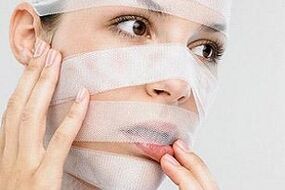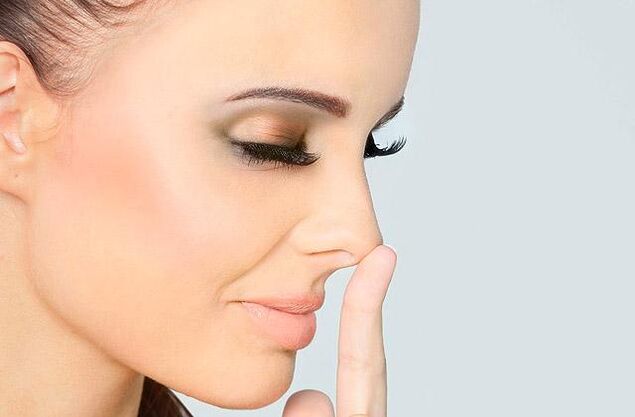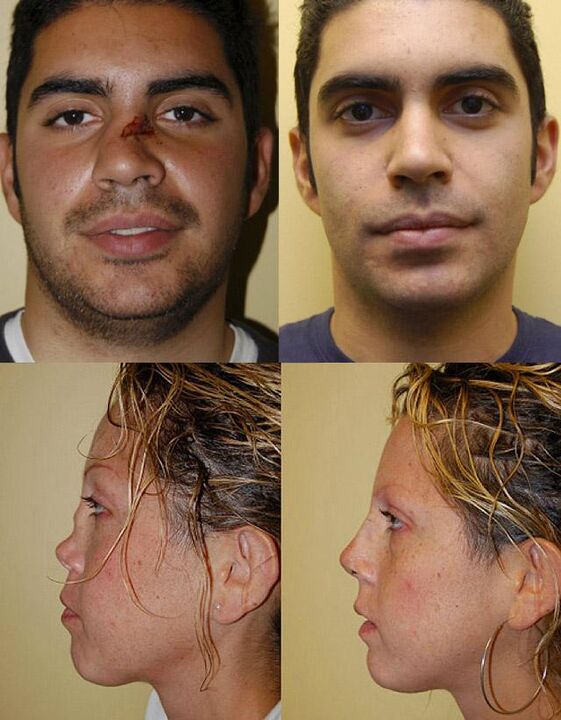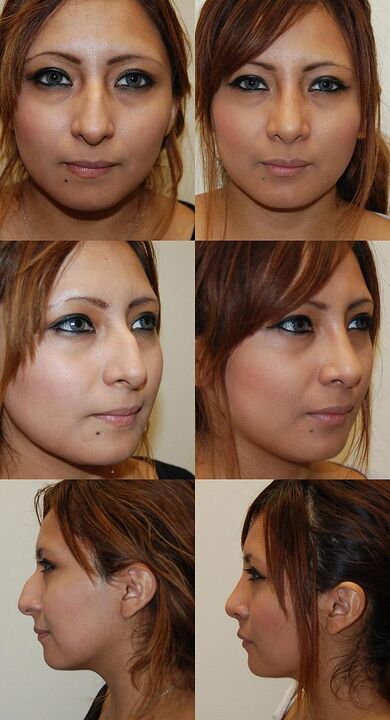
Rhinoplasty (rhinoplasty) is the use of plastic surgery techniques to correct, repair and correct the structure of the nose. Used for medical and aesthetic reasons.
Despite its popularity, nose correction surgery is still considered one of the most difficult operations.
Nose repair surgery has been performed for thousands of years. Long before our time, ancient manuscripts proved the successful experience of this procedure.
Compared with ancient doctors, medicine is far ahead. Modern rhinoplasty is not so much a medical necessity as it is a cosmetic surgery.
Indications for rhinoplasty
Every plastic surgery is a complex creative process that combines solving aesthetic problems with the preservation or restoration of specific functional characteristics of the organ (in this case, it is nasal breathing).
Therefore, rhinoplasty can be performed for therapeutic and cosmetic purposes. The best age to do it is 25-35 years old.
The medical indications are:
- Congenital nasal septum deformity;
- Polyps and turbinate hypertrophy;
- Traumatic injury and post-traumatic changes of bone, cartilage, physiology (due to uneven tissue development) or compensatory curvature of the nasal septum;
- Obvious violation or no possibility of nasal breathing at all.
Changes in the correct anatomical structure of the nose are usually the cause of dysfunction and pathological conditions-shortness of breath, atrophy or hypertrophy of the nasal mucosa, sinusitis, otitis media, frequent respiratory diseases, snoring at night.
In addition, in children, such defects can lead to long-term hypoxia in the brain, which not only causes their physical development delay, but also leads to mental retardation, which affects their intellectual development and behavioral response. Therefore, children under the age of 18 can also undergo rhinoplasty surgery.
More than 60% of rhinoplasty is due to the patient's desire to improve the shape of the nose to achieve complete harmony in its appearance. Plastic surgeon services are becoming more and more popular. The aesthetic indications of rhinoplasty are divided into two categories:
- Objective-these are disproportionate and unattractive nose sizes or shapes;
- Subjective or psychological: There is no specific standard for evaluating beauty. Everyone has their own established stereotypes. Therefore, for personal reasons, he may not like his nose.
These reasons often affect people's occupations and interpersonal relationships, resulting in dissatisfaction and low self-esteem, especially in a female environment, leading to social disorders.
Rhinoplasty for aesthetic purposes is suitable for the following situations:
- The size of the nose is disproportionate to the entire face-too big or on the contrary, too small;
- Congenital or acquired deformities;
- Curved nasal septum;
- Dilated nostrils, hump;
- Bifurcation, lowering or too high, asymmetrical tip, and mismatch with the height of the back of the nose
- Saddle shape
- The aesthetic effect of the previous operation was not satisfactory.
In many cases, the medical and aesthetic indications are the same and are the result of the same anatomical defect.

Types of rhinoplasty
According to the goal pursued and the technique of surgical intervention, rhinoplasty is divided into:
- The purpose of reconstruction is to restore anatomical obstacles caused by improper intrauterine growth, trauma or disease.
- Aesthetics-correct existing defects.
According to the same standard, there are several types of rhinoplasty:
- The nose shrinks or enlarges.
- Backrest alignment-correct saddle depression or eliminate hump.
- Correct the aesthetic defects of the nib.
- Septum correction (nasoplasty).
- Post-traumatic reconstruction of the structure.
All types of operations are broken down into:
- basic;
- Minor;
- repeat.
Access technology
When performing rhinoplasty, depending on the access options, use the following techniques:
- Closed rhinoplasty,The incision can be made in the nasal cavity. The closed pathway is subdivided into edges (along the inner surface of the wing of the nose), transseptum, interstitial and transcartilage. After the incision, the soft tissue is separated (separated) from the cartilage and bone that make up the frame, which allows you to perform the necessary operations freely. The closed rhinoplasty is less traumatic than the open rhinoplasty, which eliminates arterial damage and tissue dystrophy. The scars after surgery are completely invisible because they are located in the nasal cavity. It is used most often, especially for aesthetic rhinoplasty.
- Open rhinoplasty-The incision runs along the columella (the part of the skin that folds between the nostrils) and the junction of the alar and the lips. This technique is used in situations where another (closed) way is not allowed to complete the task. It allows you to lift up the soft tissue and cartilage to fully contact the inside of the nose and operate under continuous visual control. Open rhinoplasty is necessary to correct particularly severe changes and technically complex and important surgery-obvious nose deformities, especially lateral displacement; nose deformities combined with deformities such as "cleft lip" or hard palate; use of transplantsReconstruction. The disadvantage of open rhinoplasty is that obvious scars will be formed after the operation, and the forced injury of the nasal columella artery will result in obvious and long-lasting tissue edema after the operation.
Any type of rhinoplasty is performed under one of the general anesthesia and usually lasts 1-2 hours. Sometimes their duration can reach three or more hours.
How does rhinoplasty work?
The operation is carried out in the following order:
- Perform nasal septum correction;
- If necessary, reduce the shell of the nose;
- If you need to form a uniform contour, you need to correct the bridge of the nose;
- The bones are dissected and moved to reduce the pyramid of the nose;
- Straighten your nose
- Tip correction.
Repair rhinoplasty
If the area has already undergone surgery, consider reshaping the nose. The final formation of the nose after plastic surgery occurs within six months to one year. This period is the best period for reoperation. It is executed in the following situations:
- It is impossible to achieve the goal in one stage;
- The result of the first operation is not satisfactory;
- Need to correct the problems that still exist after the initial rhinoplasty.
According to world statistics, 25-30% of patients who have received the first rhinoplasty require a second corrective surgery. This is considered normal. It usually lasts no more than half an hour and is performed under local anesthesia. Corrective rhinoplasty can allow you to correct scar defects and make the shape of the nose aesthetically pleasing to meet the needs of surgeons and patients.
In the case of poor initial performance or unfavorable recovery period, it is much more difficult to perform repeated rhinoplasty, which usually depends on the individual characteristics and complications of the body. Such operations require more in-depth inspections and more thorough preparations. According to one of the options, they represent mature plastics, but in general, they become more complex and time-consuming. Small blemishes during repeated plastic surgery can lead to the destruction of the final shape, for example, not only the shape of the tip, but also the obvious deformation of the entire nose.
Complications and surgical preparation
Rhinoplasty is considered to be one of the most difficult plastic surgery, and the result depends largely on the skill and experience of the surgeon. Complications occur in 4-15% of cases. They may occur during surgery (bleeding, skin rupture, tearing of mucous cartilage flaps, impaired integrity of bone cones, bone fractures, etc. ) and after surgery.
Complications that may occur after rhinoplasty:
- Functional-atrophic rhinitis, nasal breathing difficulties, loss of smell, temporary or permanent reduction or complete loss of skin sensitivity of the nose and upper lip;
- Aesthetics-previous defects have not changed or deteriorated;
- Psychology-patients' dissatisfaction with the results of plastic surgery;
- Infectious-prolonged swelling and inflammation, purulent;
- Pigmentation of the skin of the nose, formation of the vascular system, mucosal adhesions and rough scars;
- Repeated nosebleeds and necrosis of soft tissue or cartilage.
Preparations include:
- Consult with a plastic surgeon to determine the technical possibilities that meet the patient's wishes during this period.
- Conduct general research-clinical and biochemical blood tests, coagulation tests (coagulation charts), general urinalysis, hepatitis, HIV, syphilis (RW), electrocardiogram tests.
- Carry out (if necessary) special studies-pictures of sinuses, nasal endoscopy to determine accompanying abnormalities and pathological changes.
- The computer simulation allows the patient to compare the initial state of the nose with the results of future rhinoplasty.
- Consult a therapist and professional experts (in the case of chronic diseases).
- All examinations will be checked by an anaesthetist.
- Two weeks before the operation, he refused to take drugs that affect the coagulation process-acetylsalicylic acid and its analogs, and anticoagulants.
- Stop taking sedatives and sleeping pills on the day of the intervention.
Contraindications and rehabilitation
Absolute contraindications for rhinoplasty:
- There are any serious forms of chronic systemic diseases (endocrine, cardiovascular, lung);
- Acute infectious disease;
- Coagulation disorders;
- Menstrual days.
The basic recovery duration of rhinoplasty surgery is as long as 3 weeks. However, when evaluating the results, the period for the complete end of the recovery period is determined by the doctor, which is 6-12 months. During this period, certain restrictions must be observed.
After the intervention, 1-1. 5 weeks later, the plaster model and sutures were removed. For the first two weeks, do not wash with hot water or take a hot bath, because bleeding, bruising, and swelling may spread to the entire face and neck. Just sleep on your back in a higher position, which helps to promote breathing and reduce swelling. In dusty places, it is recommended to wear a face mask. Avoid bending and lifting weights.
In addition, within 3 months, you must stop wearing glasses and wearing tight or heavy hats. You cannot visit the swimming pool and sunbathe within 3 months. In hot weather and sunlight, it is recommended to use an umbrella or a wide-brimmed hat.
When planning rhinoplasty surgery, experienced surgeons follow three principles of restriction: restrictions determined by the surgeon; restrictions imposed by the patient; restrictions related to the patient’s condition and the anatomical characteristics of the nose.



price
The cost of the operation depends on the complexity of the correction.
Testimonials
A woman's comment
"Because of the shape of my nose, I have always had a complex. It is too long, has a hump, and the tip of the nose seems to be bifurcated. Last year I decided to do rhinoplasty. If I did it early, then my life would be better now. ". They removed all the defects. They even repaired the diaphragm. I don't even know the flaws. My nose is perfect, just like myself. "
A man's comment
"After I broke my nose several times, the nasal septum shifted. I couldn't breathe normally and snored very badly at night. The diagnosis showed that I was temporarily holding my breath while sleeping. The nose looked ugly and shifted to one side. I had a bulge. Nasal surgery to straighten my nose and get rid of the problems related to the displacement of the nasal septum. I did this. I am satisfied with the results. Now my nose is normal, just like before the fracture. It always breathes and I don’tSnoring again. "
Rhinoplasty is not always a whim, but in most cases, it is objectively necessary. It is very important to choose a competent surgeon and make sure that you have no contraindications to surgery.




















